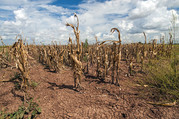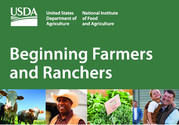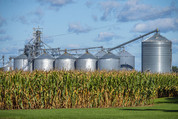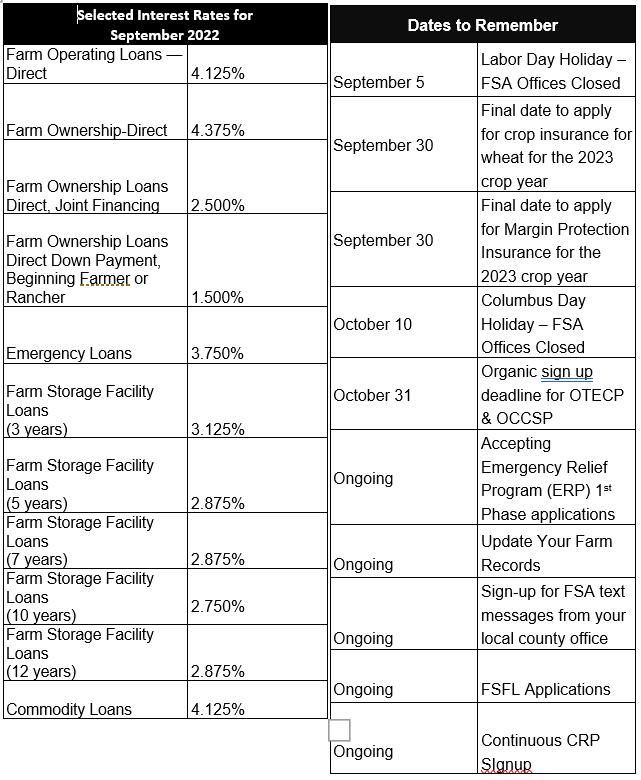In This Issue:
Here we are in mid-September and I have recently noticed the crops rapidly maturing in the last ten days, changing from a deep, dark green to golden harvest tones. I would like to start my message this month by saying, if you are experiencing a financial stress period and are unable to make payments on an FSA loan, there are options for FSA borrowers, just contact your local FSA Farm Loan Manager to learn about these options.
Producers with sealed bins of grain under a Marketing Assistance Loan who may be considering emptying those bins, to make room for new grain, please Call Before You Haul.
If loan grain has been disposed of through feeding, selling or any other form of disposal without prior written authorization from the county office staff, it is considered unauthorized disposition. The financial penalties for unauthorized dispositions are severe and a producer’s name will be placed on a loan violation list for a two-year period. Always call before you haul any grain under loan.
I would like to recommend that all producers whether you grow grain, specialty crops or raise livestock and have not already obtained an FSA farm number, please contact your local county office and do so now. Producers are required to have a farm number, in order to participate, in USDA farm programs.
I would also like to place a focus on Beginning Farmer and Rancher Loans this month.
The Farm Service Agency (FSA) assists beginning farmers to finance agricultural enterprises. Under these designated farm loan programs, FSA can provide financing to eligible applicants through either direct or guaranteed loans. FSA defines a beginning farmer as a person who:
- Has operated a farm for not more than 10 years
- Will materially and substantially participate in the operation of the farm
- Agrees to participate in a loan assessment, borrower training and financial management program sponsored by FSA
- Does not own a farm in excess of 30 percent of the county’s average size farm.
For more information contact, contact your local County USDA Service Center or visit fsa.usda.gov.
As you begin/continue your fall harvesting, please remember to take a minute and stay safe on and around the farm every day.
Sincerely,
Scott Halpin
State Executive Director
The 2018 Farm Bill extends loan authority through 2023 for Marketing Assistance Loans (MALs) and Loan Deficiency Payments (LDPs).
MALs and LDPs provide financing and marketing assistance for wheat, feed grains, soybeans, and other oilseeds, pulse crops, rice, peanuts, cotton, wool and honey. MALs provide you with interim financing after harvest to help you meet cash flow needs without having to sell your commodities when market prices are typically at harvest-time lows. A producer who is eligible to obtain a loan, but agrees to forgo the loan, may obtain an LDP if such a payment is available. Marketing loan provisions and LDPs are not available for sugar and extra-long staple cotton.
FSA is now accepting requests for 2022 MALs and LDPs for all eligible commodities after harvest. Requests for loans and LDPs shall be made on or before the final availability date for the respective commodities.
Commodity certificates are available to loan holders who have outstanding nonrecourse loans for wheat, upland cotton, rice, feed grains, pulse crops (dry peas, lentils, large and small chickpeas), peanuts, wool, soybeans and designated minor oilseeds. These certificates can be purchased at the posted county price (or adjusted world price or national posted price) for the quantity of commodity under loan, and must be immediately exchanged for the collateral, satisfying the loan. MALs redeemed with commodity certificates are not subject to Adjusted Gross Income provisions.
To be considered eligible for an LDP, you must have form CCC-633EZ, Page 1 on file at your local FSA Office before losing beneficial interest in the crop. Pages 2, 3 or 4 of the form must be submitted when payment is requested.
Marketing loan gains (MLGs) and loan deficiency payments (LDPs) are no longer subject to payment limitations, actively engaged in farming and cash-rent tenant rules.
Adjusted Gross Income (AGI) provisions state that if your total applicable three-year average AGI exceeds $900,000, then you’re not eligible to receive an MLG or LDP. You must have a valid CCC-941 on file to earn a market gain of LDP. The AGI does not apply to MALs redeemed with commodity certificate exchange.
For more information and additional eligibility requirements, contact your local County USDA Service Center or visit fsa.usda.gov.

The U.S. Department of Agriculture (USDA) today announced another installment (phase) in assistance to commodity and specialty crop producers impacted by natural disaster events in 2020 and 2021. More than 18,000 producers will soon receive new or updated pre-filled disaster applications to offset eligible crop losses. Approximately $6.4 billion has already been distributed to 165,000 producers through USDA’s Farm Service Agency’s (FSA) Emergency Relief Program (ERP).
FSA will begin mailing pre-filled applications in late August to producers who have potentially eligible losses and:
- Received crop insurance indemnities for qualifying 2020 and 2021 disaster events after May 2, 2022.
- Received crop insurance indemnities associated with Nursery, Supplemental Coverage Option (SCO), Stacked Income Protection Plan (STAX), Enhanced Coverage Option (ECO) and Margin Protection (MP) policies.
- New primary policyholders not included in the initial insured producer Phase 1 mailing from May 25, 2022, because their claim records had not been filled.
- Certain 2020 prevent plant losses related to qualifying 2020 disaster events that had only been recorded in crop insurance records as related to 2019 adverse weather events and, as such, were not previously provided in applications sent earlier this year.
- New Substantial Beneficial Interest (SBI) records, including SBIs where tax identification numbers were corrected.
Producers are expected to receive assistance direct deposited into their bank account within three business days after they sign and return the pre-filled application to the FSA county office and the county office enters the application into the system.
Before applying any program payment factors or eligibility criteria, it is estimated that this next installment (phase) may generate about $756 million in assistance.
Emergency Relief Payments to Date
This emergency relief under ERP complements ERP assistance recently provided to more than 165,000 producers who had received crop insurance indemnities and Noninsured Crop Disaster Assistance Program (NAP) payments for qualifying losses. USDA has processed more than 255,000 applications for ERP, and to date, has made approximately $6.4 billion in payments to commodity and specialty crop producers to help offset eligible losses from qualifying 2020 and 2021 natural disasters. Also, earlier this year, staff processed more than 100,000 payments through the Emergency Livestock Relief Program (ELRP) and paid eligible producers more than $601.3 million for 2021 grazing losses within days of the program announcement.
Phase Two
The second phase of both ERP and ELRP will be aimed at filling gaps and provide assistance to producers who did not participate in or receive payments through the existing risk management programs that are being leveraged for phase one implementation. USDA will keep producers and stakeholders informed as program details are made available.
More Information
In addition, on August 18, 2022, USDA published a technical correction to the Notice of Funds Availability for ERP and ELRP to clarify how income from the sale of farm equipment and the provision of production inputs and services to farmers, ranchers, foresters, and farm operations are to be considered in the calculation of average adjusted gross farm income. Producers whose average adjusted gross farm income is at least 75% of the producer’s the average Adjusted Gross Income can gain access to a higher payment limitation.
ERP and the previously announced ELRP are authorized by the Extending Government Funding and Delivering Emergency Assistance Act, which President Biden signed into law in 2021. The law provided $10 billion to help agricultural producers impacted by wildfires, droughts, hurricanes, winter storms and other eligible disasters experienced during calendar years 2020 and 2021.
For more information on ERP and ELRP eligibility, program provisions for historically underserved producers as well as Frequently Asked Questions, producers can visit FSA’s Emergency Relief webpage. A new public-facing dashboard on the ERP webpage has information on ERP payments that can be sorted by crop type – specialty or non-specialty– specific commodities and state. FSA will update the dashboard every Monday.
Additional USDA disaster assistance information can be found on farmers.gov, including the Disaster Assistance Discovery Tool, Disaster-at-a-Glance fact sheet and Farm Loan Discovery Tool. For FSA and Natural Resources Conservation Service programs, producers should contact their local USDA Service Center. For assistance with a crop insurance claim, producers and landowners should contact their crop insurance agent.
|

The Farm Service Agency (FSA) assists beginning farmers to finance agricultural enterprises. Under these designated farm loan programs, FSA can provide financing to eligible applicants through either direct or guaranteed loans. FSA defines a beginning farmer as a person who:
- Has operated a farm for not more than 10 years
- Will materially and substantially participate in the operation of the farm
- Agrees to participate in a loan assessment, borrower training and financial management program sponsored by FSA
- Does not own a farm in excess of 30 percent of the county’s average size farm.
For more information contact, contact your local County USDA Service Center or visit fsa.usda.gov.
|
Producers with farmers.gov accounts can now access farm records and maps online, the latest self-service feature added to the U.S. Department of Agriculture (USDA) website.
You can quickly and easily access your land information in real time by desktop computer, tablet or phone. Capabilities include:
- View, print and export detailed farm records such as cropland, base acres, yields, CRP acres, land ownership details, and much more;
- View, print and export farm/tract maps that can be provided to lenders, chemical or fertilizer providers, and FSA for reporting acreage and crop insurance agents; and
- Export common land unit (field) boundaries as ESRI shapefiles.
The ability to access these records on demand without a visit to the service center saves you time and money.
Farmers.gov now includes the most popular functionalities from FSAFarm+, the FSA portal for producers, while providing enhanced functionality and an improved user experience. A new enhancement expands the scope of accessibility to include farmers and ranchers who are members of an entity, as well as people with a power of attorney form (FSA-211) on file with FSA.
Managing USDA Business Online
Using farmers.gov, producers, entities and those acting on their behalf can also:
- View, upload, download, and e-sign conservation documents.
- Request financial assistance, including submitting a program application.
- View and submit conservation requests.
- View technical references and submit questions.
- Access information on current and past conservation practices, plans and contracts.
- Report practice completion and request practice certification.
- View farm loan and interest information (producers only).
Future plans include adding the ability to import and view other shapefiles, such as precision agriculture planting boundaries.
To access your information, you’ll will need a USDA eAuth account to login to farmers.gov. After obtaining an eAuth account, producers should visit farmers.gov and sign into the site’s authenticated portal via the Sign In/Sign Up link at the top right of the website. Google Chrome, Mozilla Firefox or Microsoft Edge are the recommended browsers to access the feature.
In addition to the self-service features available by logging into farmers.gov, the website also has ample information on USDA programs, including pandemic assistance, farm loans, disaster assistance, conservation programs and crop insurance. Recently, USDA updated the navigation and organization of the site as well as added some new webpages, including “Get Involved,” “Common Forms,” and “Translations.” Learn more about these changes.

Livestock inventory records are necessary in the event of a natural disaster, so remember to keep them updated.
When disasters strike, the USDA Farm Service Agency (FSA) can help you if you’ve suffered excessive livestock death losses and grazing or feed losses due to eligible natural disasters.
To participate in livestock disaster assistance programs, you’ll be required to provide verifiable documentation of death losses resulting from an eligible adverse weather event and must submit a notice of loss to your local FSA office within 30 calendar days of when the loss of livestock is apparent. For grazing or feed losses, you must submit a notice of loss to your local FSA office within 30 calendar days of when the loss is apparent and should maintain documentation and receipts.
You should record all pertinent information regarding livestock inventory records including:
- Documentation of the number, kind, type, and weight range of livestock
- Beginning inventory supported by birth recordings or purchase receipts.
Producers are encouraged to file acreage reports which include pasture and hayland acres to ensure eligibility for current and future programs. For more information on documentation requirements, contact your local County USDA Service Center or visit fsa.usda.gov.
|

FSA’s Farm Storage Facility Loan (FSFL) program provides low-interest financing to producers to build or upgrade storage facilities and to purchase portable (new or used) structures, equipment and storage and handling trucks.
The low-interest funds can be used to build or upgrade permanent facilities to store commodities. Eligible commodities include corn, grain sorghum, rice, soybeans, oats, peanuts, wheat, barley, minor oilseeds harvested as whole grain, pulse crops (lentils, chickpeas, and dry peas), hay, honey, renewable biomass, fruits, nuts and vegetables for cold storage facilities, floriculture, hops, maple sap, rye, milk, cheese, butter, yogurt, meat and poultry (unprocessed), eggs, and aquaculture (excluding systems that maintain live animals through uptake and discharge of water). Qualified facilities include grain bins, hay barns and cold storage facilities for eligible commodities.
Loans up to $50,000 can be secured by a promissory note/security agreement and loans between $50,000 and $100,000 may require additional security. Loans exceeding $100,000 require additional security.
Producers do not need to demonstrate the lack of commercial credit availability to apply. The loans are designed to assist a diverse range of farming operations, including small and mid-sized businesses, new farmers, operations supplying local food and farmers markets, non-traditional farm products, and underserved producers.
To learn more about the FSA Farm Storage Facility Loan, visit www.fsa.usda.gov/pricesupport or contact your local FSA county office. To find your local FSA county office, visit http://offices.usda.gov.
|
The National Environmental Policy Act (NEPA) requires Federal agencies to consider all potential environmental impacts for federally funded projects before the project is approved.
For all Farm Service Agency (FSA) programs, an environmental review must be completed before actions are approved, such as site preparation or ground disturbance. These programs include, but are not limited to, the Emergency Conservation Program (ECP), Farm Storage Facility Loan (FSFL) program and farm loans. If project implementation begins before FSA has completed an environmental review, the request will be denied. Although there are exceptions regarding the Stafford Act and emergencies, it’s important to wait until you receive written approval of your project proposal before starting any actions.
Applications cannot be approved until FSA has copies of all permits and plans. Contact your local FSA office early in your planning process to determine what level of environmental review is required for your program application so that it can be completed timely.
The USDA’s Risk Management Agency (RMA) reminds Illinois wheat growers that the final date to apply for crop insurance coverage or for current policyholders to make changes to their existing policy for the 2023 crop year is the sales closing date of September 30.
Federal crop insurance is critical to the farm safety net. It helps producers and owners manage revenue risks and strengthens the rural economy. Producers may select from several coverage options, including yield coverage, revenue protection, and area risk policies.
For producers without insurance, contact a crop insurance agent to get information on coverages, options, and premium cost. For producers who have coverage, this is the time to review your policy with an agent to make sure it meets your needs.
One option added last year was the Quality Loss Option. This is an option you may elect to improve your Actual Production History (APH) for years in which you suffered a quality loss. The Quality Loss Option must be elected by the sales closing date of September 30. When elected, the quality loss will replace post-quality adjusted production with the pre-quality adjusted production for any year the insured filed a Notice of Loss. For more information on this and other crop insurance options, contact your crop insurance agent.
RMA is authorizing additional flexibilities due to coronavirus while continuing to support producers, working through Approved Insurance Providers (AIPs) to deliver services, including processing policies, claims and agreements. RMA staff are working with AIPs and other customers by phone, mail and electronically to continue supporting crop insurance coverage for producers. On farmers.gov, you can find more information on USDA’s response and relief for producers and use other tools and resources.
Crop insurance is sold and delivered solely through private crop insurance agents. A list of crop insurance agents is available at all USDA Service Centers and online at the RMA Agent Locator. Learn more about crop insurance and the modern farm safety net at rma.usda.gov. If producers have additional questions, they can contact RMA’s Regional Office in Springfield at (217) 241-6600.
USDA touches the lives of all Americans each day in so many positive ways. In the Biden-Harris Administration, USDA is transforming America’s food system with a greater focus on more resilient local and regional food production, fairer markets for all producers, ensuring access to healthy and nutritious food in all communities, building new markets and streams of income for farmers and producers using climate smart food and forestry practices, making historic investments in infrastructure and clean energy capabilities in rural America, and committing to equity across the Department by removing systemic barriers and building a workforce more representative of America. To learn more, visit usda.gov.
 |
|
|
The U.S. Department of Agriculture (USDA) is investing $10 million in a new initiative to sample, measure, and monitor soil carbon on Conservation Reserve Program (CRP) acres to better quantify the climate outcomes of the program. CRP is an important tool in the Nation’s fight to reduce the worst impacts of climate change facing our farmers, ranchers, and foresters. This initiative will begin implementation in fall 2021 with three partners. Today’s announcement is part of a broader, long-term soil carbon monitoring effort across agricultural lands that supports USDA’s commitment to deliver climate solutions to agricultural producers and rural America through voluntary, incentive-based solutions.
These models include the Daily Century Model, or DayCent, which simulates the movement of carbon and nitrogen through agricultural systems and informs the National Greenhouse Gas Inventory. Data will also be used to strengthen the COMET-Farm and COMET-Planner tools, which enable producers to evaluate potential carbon sequestration and greenhouse gas emission reductions based on specific management scenarios.
USDA partners will conduct soil carbon sampling on three categories of CRP practice types: perennial grass, trees, and wetlands.
Perennial grasses: In consultation with USDA, Michigan State University will sample and measure soil carbon and bulk density of CRP grasslands (including native grass plantings, rangelands, and pollinator habitat plantings) at an estimated 600 sites across the U.S. with a focus in the central states during this five-year project. This information will be used to model and compare the climate benefits of CRP. Partners include the University of Wisconsin-Madison, the University of Arkansas at Pine Bluff, Deveron, an agriculture technology company, and Woods End Laboratories.
Trees: Mississippi State University will partner with Alabama A&M University to collect above and below ground data at 162 sites across seven states documenting CRP-related benefits to soil and atmospheric carbon levels. Information will help further calibrate the DayCent model. This five-year project will focus within the Mississippi Delta and Southeast states.
Wetlands: Ducks Unlimited and its partners will collect data on carbon stocks in wetland soils as well as vegetation carbon levels at 250 wetland sites across a 15-state area in the central U.S. Data will support the DayCent and additional modeling. Partners for this five-year project include: Migratory Bird Joint Venture, Intertribal Research and Resource Center at United Tribes Technical College, Clemson University, Kenyon College, Lincoln University, Pennsylvania State University, the University of Missouri, and the University of Texas at Austin.
CRP Monitoring, Assessment, and Evaluation Projects
These three Climate Change Mitigation Assessment Initiative projects are funded through FSA’s program to work with partners to identify Monitoring, Assessment and Evaluation (MAE) projects to quantify CRP environmental benefits to water quality and quantity, wildlife, and rural economies.
Applications for projects were welcome from all organizations, including public, private, nonprofit institutions, and educational institutions including historically Black colleges and universities, Tribal colleges and universities and Hispanic-serving institutions or organizations.
For more details on the all the awarded MAE projects, visit the FSA Monitoring Assessment & Evaluation webpage.
About the Conservation Reserve Program
CRP is one of the world’s largest voluntary conservation programs, with an established track record of preserving topsoil, sequestering carbon, reducing nitrogen runoff and providing healthy habitat for wildlife.
In exchange for a yearly rental payment, agricultural producers enrolled in the program agree to remove environmentally sensitive land from production and plant species that will improve environmental health and quality. In general, land is enrolled in CRP for 10 to 15 years, with the option of re-enrollment. FSA offers multiple CRP signups, including the general signup and continuous signup, as well as Grassland CRP and pilot programs focused on soil health and clean water. In 2021, producers and landowners enrolled more than 5.3 million acres in CRP signups, surpassing USDA’s 4-million-acre goal.
Earlier this year, USDA announced updates to CRP including higher payment rates, new incentives for environmental practices, and a more targeted focus on the program’s role in climate change mitigation. This included a new Climate-Smart Practice Incentive for CRP general and continuous signups that aims to increase carbon sequestration and reduce greenhouse gas emissions. Climate-Smart CRP practices include establishment of trees and permanent grasses, development of wildlife habitat, and wetland restoration. Download the “What’s New” fact sheet to learn more about CRP updates.
If you have experienced delays in receiving Agriculture Risk Coverage (ARC) and Price Loss Coverage (PLC) payments, Loan Deficiency Payments (LDPs) and Market Gains on Marketing Assistance Loans (MALs), it may be because you have not filed form CCC-941, Adjusted Gross Income Certification.
If you don’t have a valid CCC-941 on file for the applicable crop year you will not receive payments. All farm operator/tenants/owners who have not filed a CCC-941 and have pending payments should IMMEDIATELY file the form with their recording county FSA office. Farm operators and tenants are encouraged to ensure that their landowners have filed the form.
FSA can accept the CCC-941 for 2018, 2019, 2020, 2021, and 2022. Unlike the past, you must have the CCC-941 certifying your AGI compliance before any payments can be issued.
The USDA’s Risk Management Agency (RMA) reminds corn and soybean growers that the final date to apply for the Margin Protection insurance plan for the 2023 crop year is September 30. This policy is available in select counties in Illinois, Indiana, Michigan, and Ohio.
Federal crop insurance is critical to the farm safety net. It helps producers and owners manage revenue risks and strengthens the rural economy.
Margin Protection is an area-based insurance plan that provides coverage against an unexpected decrease in operating margin (revenue less input costs), caused by reduced county yields, reduced commodity prices, increased prices of certain inputs, or any combination of these perils. Because Margin Protection is area-based (average for a county), an individual farm may have a decrease in its margin but not receive an indemnity or vice-versa.
You can buy Margin Protection and also buy a Yield Protection policy or a Revenue Protection policy (denoted as a base policy) on the same acreage.
To learn more about Margin Protection, please contact a crop insurance agent. There is also a national fact sheet on Margin Protection as well as Frequently Asked Questions on the RMA Website.
RMA is authorizing additional flexibilities due to coronavirus while continuing to support producers, working through Approved Insurance Providers (AIPs) to deliver services, including processing policies, claims and agreements. RMA staff are working with AIPs and other customers by phone, mail and electronically to continue supporting crop insurance coverage for producers. On farmers.gov, you can find more information on USDA’s response and relief for producers and use other tools and resources.
Crop insurance is sold and delivered solely through private crop insurance agents. A list of crop insurance agents is available at all USDA Service Centers and online at the RMA Agent Locator. Learn more about crop insurance and the modern farm safety net at rma.usda.gov. If producers have additional questions, they can contact RMA’s Regional Office in Springfield at (217) 241-6600.
USDA touches the lives of all Americans each day in so many positive ways. In the Biden-Harris Administration, USDA is transforming America’s food system with a greater focus on more resilient local and regional food production, fairer markets for all producers, ensuring access to healthy and nutritious food in all communities, building new markets and streams of income for farmers and producers using climate smart food and forestry practices, making historic investments in infrastructure and clean energy capabilities in rural America, and committing to equity across the Department by removing systemic barriers and building a workforce more representative of America. To learn more, visit usda.gov.
 |
|
Bins are ideally designed to hold a level volume of grain. When bins are overfilled and grain is heaped up, airflow is hindered, and the chance of spoilage increases.
Producers who take out marketing assistance loans and use the farm-stored grain as collateral should remember that they are responsible for maintaining the quality of the grain through the term of the loan.
|
The term “sodbusting” is used to identify the conversion of land from native vegetation to commodity crop production after December 23, 1985. As part of the conservation provisions of the Food Security Act of 1985, if you’re proposing to produce agricultural commodities (crops that require annual tillage including one pass planting operations and sugar cane) on land that has been determined highly erodible and that has no crop history prior to December 23, 1985, that land must be farmed in accordance with a conservation plan or system that ensures no substantial increase in soil erosion.
Eligibility for many USDA programs requires compliance with a conservation plan or system on highly erodible land (HEL) used for the production of agricultural commodities. This includes Farm Service Agency (FSA) loan, disaster assistance, safety net, price support, and conservation programs; Natural Resources Conservation Service (NRCS) conservation programs; and Risk Management Agency (RMA) Federal crop insurance.
Before you clear or prepare areas not presently under production for crops that require annual tillage, you are required to file Form AD-1026 “Highly Erodible Land Conservation and Wetland Conservation Certification,” with FSA indicating the area to be brought into production. The notification will be referred to NRCS to determine if the field is considered highly erodible land. If the field is considered HEL, you are required to implement a conservation plan or system that limits the erosion to the tolerable soil loss (T) for the predominant HEL soil on those fields.
In addition, prior to removing trees or conducting any other land manipulations that may affect wetlands, remember to update form AD-1026, to ensure you remain in compliance with the wetland conservation provisions.
Prior to purchasing or renting new cropland acres, it is recommended that you check with your local USDA Service Center to ensure your activities will be in compliance with the highly erodible land and wetland conservation provisions.
For additional information on highly erodible land conservation and wetland conservation compliance, contact your local USDA Service Center.

|